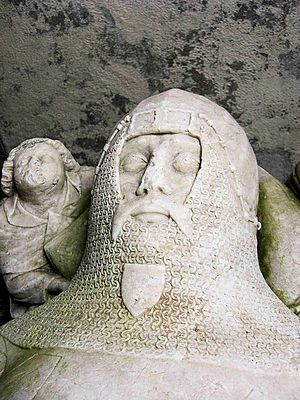Tudur ap Goronwy facts for kids
Quick facts for kids
Tudur ap Goronwy
|
|
|---|---|
| Born | about 1310 |
| Died | about 1367 |
| Resting place | Llanfaes Friary |
| Occupation | Royal officer |
| Spouse(s) | Marged ferch Tomos |
| Children |
|
Tudur ap Goronwy (born around 1310, died around 1367) was an important Welsh figure. He owned land, served as a soldier, and worked as an administrator. Tudur was part of the famous Tudors of Penmynydd family from Anglesey island in Wales.
Contents
Early Life and Family
Tudur ap Goronwy was born around the year 1310. He was one of two sons of Goronwy ap Tudur Hen and his wife, Gwerfyl ferch Madog. His father, Goronwy, had fought for King Edward I of England. He also remained loyal to King Edward II of England.
When his father passed away in 1331, Tudur inherited the family lands. These lands had been passed down through his family from his grandfather, Tudur Hen. Tudur lived in the village of Trecastell.
Tudur's brother, Hywel ap Goronwy, also played an important role. Hywel became a priest and worked at Bangor Cathedral. He later became the Archdeacon of Anglesey.

Tudur's Career and Influence
Tudur ap Goronwy served as a royal officer for the island of Anglesey. This meant he worked for the king in that area. He also joined the English army of King Edward III of England. He fought in battles in France around 1337.
A Local Conflict
In 1345, Tudur and his brother Hywel were involved in a serious local incident. Henry Shalford, a new representative for the Prince of Wales in North Wales, was attacked. This happened near Hywel's home in Bangor. Tudur was said to have led the group of men involved.
Some people believed Shalford knew too much about problems among important Welsh leaders. This event caused fear among English residents in the area. It also made them suspicious of the Welsh community.
Both Tudur and Hywel were arrested after the incident. Hywel was held in Launceston and Tudur in Chester. However, both brothers were eventually released. They faced no official charges or punishment.
English residents complained that no Welsh person dared to speak against them. This showed how much power and influence Tudur and Hywel had locally. A man named Gruffydd ap Maredudd ap Dafydd said the brothers were as strong as oak trees. He meant they protected everyone who was connected to them. By 1352, both brothers were peacefully back in control of their family lands in Anglesey.
Later Life and Burial
Tudur ap Goronwy was buried in the south wall of the chancel at Llanfaes Friary. This was a Franciscan friary near Bangor, Gwynedd. The bodies of his ancestors were also buried nearby. A famous Welsh poet, Iolo Goch, wrote a special poem to honor Tudur after he died.
Tudur's Family and Legacy
Tudur ap Goronwy married twice. His first wife was Mallt ferch Madog. His second wife was Marged ferch Tomos. Marged was the daughter of Tomos ap Llewelyn and the aunt of the famous Welsh rebel, Owain Glyndŵr.
Tudur had six sons:
- Goronwy ap Tudur
- Rhys ap Tudur (from his marriage to Mallt)
- Ednyfed ap Tudur
- Gwilym ap Tudur
- Rhys ap Tudur (from his marriage to Marged)
- Maredudd ap Tudur
All of Tudur's sons became powerful figures in Anglesey and nearby areas of North Wales. Two of his sons, Rhys and Gwilym, went with King Richard II of England on a trip to Ireland in 1398.
Later, after King Richard II was removed from power, Rhys, Gwilym, and Maredudd supported their cousin, Owain Glyndŵr. They joined his Welsh uprising against King Henry IV of England.
Maredudd's son was Owain, who became known as Owen Tudor. Owen Tudor later became the grandfather of King Henry VII of England. This means Tudur ap Goronwy was an ancestor of the famous Tudor royal family!
Lineage
|
|||||||||||||||||||||||||||||||||||||||||||||||||||||||||||||||||||||||||||||||||||||||||||||||||||||||||||||||||||||||||||||||||||||||||||||||||||||||||||||||||||||||||||||||||||||||||||||||||||||||||||||||||||||||||||||||||||||||||||||||||||||||||||||||||||||||||||||||||||||||||||||||||||||||||||||||||||||||||||||||||||||||||||||||||||||||||||||||||||||||||||||||||||||||||||||||||||||||||||||||||||||||||||||||||||||||||||||||||||||||||||||||||||||||||||||||||||||||||||||||||||||||||||||||||||||||||||||||||||||||||||||||||||||||||||||||||||||||||||||||||||||||||||||||||||||||||||||||||||||||||||||||||||||||||||||||||||||||||||||||||||||||||||||||||||||||||||||||||||||||||||||||||||||||||||||||||||||||||||||||||||||||||||||||||||||||||||||||||||||||||||||||||||||||||||||||||||||||||||||||||||||||||||||||||||||||||||||||||||||||||||||||||||||||||||||||||||||||||||||||||||||||||||||||||||||||||||||||||||||||||||||||||||||||||||||||||||||||||||||||||||||||||||||||||||||||||||||||||||||||
| Notes: | |||||||||||||||||||||||||||||||||||||||||||||||||||||||||||||||||||||||||||||||||||||||||||||||||||||||||||||||||||||||||||||||||||||||||||||||||||||||||||||||||||||||||||||||||||||||||||||||||||||||||||||||||||||||||||||||||||||||||||||||||||||||||||||||||||||||||||||||||||||||||||||||||||||||||||||||||||||||||||||||||||||||||||||||||||||||||||||||||||||||||||||||||||||||||||||||||||||||||||||||||||||||||||||||||||||||||||||||||||||||||||||||||||||||||||||||||||||||||||||||||||||||||||||||||||||||||||||||||||||||||||||||||||||||||||||||||||||||||||||||||||||||||||||||||||||||||||||||||||||||||||||||||||||||||||||||||||||||||||||||||||||||||||||||||||||||||||||||||||||||||||||||||||||||||||||||||||||||||||||||||||||||||||||||||||||||||||||||||||||||||||||||||||||||||||||||||||||||||||||||||||||||||||||||||||||||||||||||||||||||||||||||||||||||||||||||||||||||||||||||||||||||||||||||||||||||||||||||||||||||||||||||||||||||||||||||||||||||||||||||||||||||||||||||||||||||||||||||||||||||

